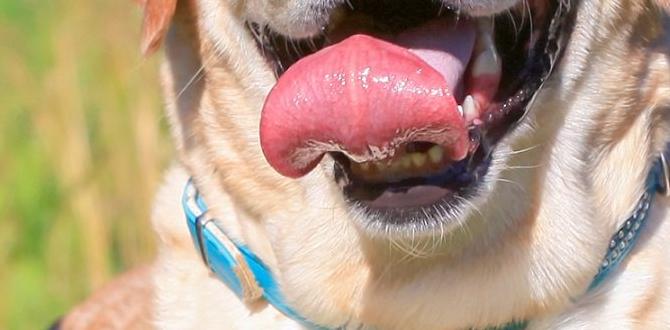Have you ever watched a puppy play? They often show interesting behaviors. One of these is dog submission signals in puppies. These signals help puppies communicate and learn. Understanding these signals is fun and helpful. Let’s dive into the world of puppy language!
Key Takeaways
- Puppies use body language to show submission.
- Belly-up position is a clear submission sign.
- Learning submission helps puppies get along.
- Dog submission signals in puppies include lowering their ears.
- Puppies show submission to avoid conflicts.
Understanding Puppy Body Language
Puppies express themselves through body language. They use it to communicate with other dogs. It’s like their secret language! One common behavior is dog submission signals in puppies. These signals help puppies show they are friendly. When a puppy feels unsure, it might show submission. This is a sign that they don’t want to fight. Instead, they want to play or be friends.
- Puppies show submission by lowering their bodies.
- Ears might be pulled back gently.
- They avoid direct eye contact.
- A wagging tail can signal friendliness.
- Licking another dog’s mouth is common.
- Rolling onto their back shows trust.
Puppies learn submission signals from their mothers and littermates. This learning helps them grow into well-mannered dogs. It’s like going to puppy school! These signals ensure they get along with others. When they lower their body or wag their tail, they are saying, “I come in peace!” Understanding these signals helps us communicate better with our furry friends.
Fun Fact: Puppies start learning body language from just three weeks old!
The Importance of Submission Signals
Why do puppies need submission signals? Imagine two puppies meeting for the first time. Without signals, they might misunderstand each other. This could lead to fights or fear. Submission signals help puppies show they are friendly. They can play and explore without problems. These signals are like a puppy’s way of shaking hands. They say, “Let’s be friends, not foes!”
Belly-Up: A Key Submission Signal
Have you noticed a puppy rolling onto its back? This is a strong submission signal. It shows trust and friendship. When a puppy does this, it’s saying, “I trust you.” This behavior is learned early on. Puppies quickly learn that showing their belly is a way to make friends. It’s a sign of peace and willingness to play together.
Comparing Puppy and Adult Dog Signals
Do puppies and adult dogs use the same signals? Yes, but there are differences. Puppies rely more on submission signals. They are learning how to interact with others. Adult dogs use these signals too but may use them differently. Adults have learned to balance play and defense. They might use signals less often, but they still show them when needed.
| Signal | Puppy Use | Adult Use |
|---|---|---|
| Belly-Up | Very Common | Less Common |
| Ears Back | Common | Moderate |
| Wagging Tail | Very Common | Common |
| Rolling Over | Very Common | Less Common |
Fun Fact: Dogs can understand each other across breeds by using these signals!
Recognizing Submission During Play
Playtime is a crucial time for learning. Puppies learn a lot about signals when they play. They chase, wrestle, and roll around. During this time, they often show dog submission signals in puppies. A puppy might stop and lay on its side. This action tells the other puppy, “I give up, let’s keep it friendly!”
- Play sessions are full of signals.
- Chasing often ends with submission.
- Wrestling includes many submission cues.
- Pausing play signals “time-out.”
- Bowing means “let’s play more!”
Recognizing these signals helps trainers and owners understand their pups better. By watching play, we can see who takes charge and who submits. This can guide us in training our dogs. Understanding these signals ensures happy and safe interactions during playtime.
Fun Fact: Play bows are a universal sign meaning “I’m just playing!”
Training Puppies with Submission Signals
Training is important for puppies. It helps them grow into well-behaved dogs. Knowing dog submission signals in puppies can aid in training. When a puppy shows submission, it is ready to learn. This makes training sessions smoother. A willing puppy is a joy to train!
- Submission signals can show readiness to learn.
- Training is more effective with a calm puppy.
- Understanding signals helps tailor training methods.
- Positive reinforcement goes well with submission.
- Trainers use signals to read puppy moods.
Recognizing a submissive puppy helps trainers adjust their approach. A respectful tone and positive reinforcement work wonders. This creates a trusting and effective learning environment. Puppies respond better when they feel understood and safe.
Fun Fact: Puppies trained with positive methods learn faster!
Helping Puppies Feel Secure
Puppies need to feel safe and secure. A secure environment helps them show dog submission signals in puppies. When a puppy feels safe, it can express itself freely. A secure puppy is a happy one! Owners can provide a loving home where puppies feel protected. This fosters good behavior and easy learning.
- Security allows puppies to express signals.
- A safe home promotes confidence.
- Trust between owner and puppy is crucial.
- A loving environment fosters growth.
- Consistency in care is important.
Helping a puppy feel secure strengthens the bond with its owner. A puppy that trusts its owner will be more open and responsive. This bond is essential for a happy and healthy life. Puppies thrive in homes where they feel loved and secure.
Fun Fact: Puppies can recognize their owner’s voice from a distance!
Conclusion
Dog submission signals in puppies are fascinating. They help puppies communicate and learn. Understanding these signals boosts our connection with them. It makes training and playtime more enjoyable. Recognizing these signals helps us build strong bonds with our furry friends.
FAQs
Question: What are dog submission signals in puppies?
Answer: Dog submission signals in puppies are behaviors that show friendliness. These signals help puppies communicate and avoid conflicts. They might lower their bodies, avoid eye contact, or offer their bellies.
Question: Why do puppies show submission signals?
Answer: Puppies show submission signals to express peace and avoid conflict. It helps them communicate their friendly intentions during play or when meeting new dogs. These signals aid in building positive relationships with other dogs.
Question: How can I recognize submission signals in my puppy?
Answer: Look for signs like lowering their body, avoiding direct eye contact, and wagging their tail. Rolling onto their back and pulling their ears back are clear dog submission signals in puppies. These behaviors show that your puppy wants to be friendly.
Question: Are submission signals the same in adult dogs?
Answer: While adult dogs use similar signals, they might show them differently. Adult dogs have learned to balance play and defense. They might use submission signals less often, but they still use them when necessary for friendly interactions.
Question: Can submission signals help in training?
Answer: Yes, recognizing dog submission signals in puppies can help in training. When a puppy shows submission, it is more ready to learn. Understanding these signals allows trainers to create a positive and effective training environment.
Question: How can I help my puppy feel secure?
Answer: Provide a loving and consistent environment. Ensure your puppy feels safe and protected. Build trust by spending quality time together and using positive reinforcement. A secure puppy is more likely to express itself freely and learn effectively.
Meet Elyse Colburn, the devoted canine companion and storyteller behind the enchanting world of “Tales, Tails, and Adventures Unleashed.” A passionate dog enthusiast with a heart full of paw prints, Elyse Colburn shares heartwarming tales and insightful adventures, celebrating the joy, loyalty, and endless antics that make every dog a true hero. Join Elyse Colburn on this tail-wagging journey, where every post is a love letter to our four-legged friends.







